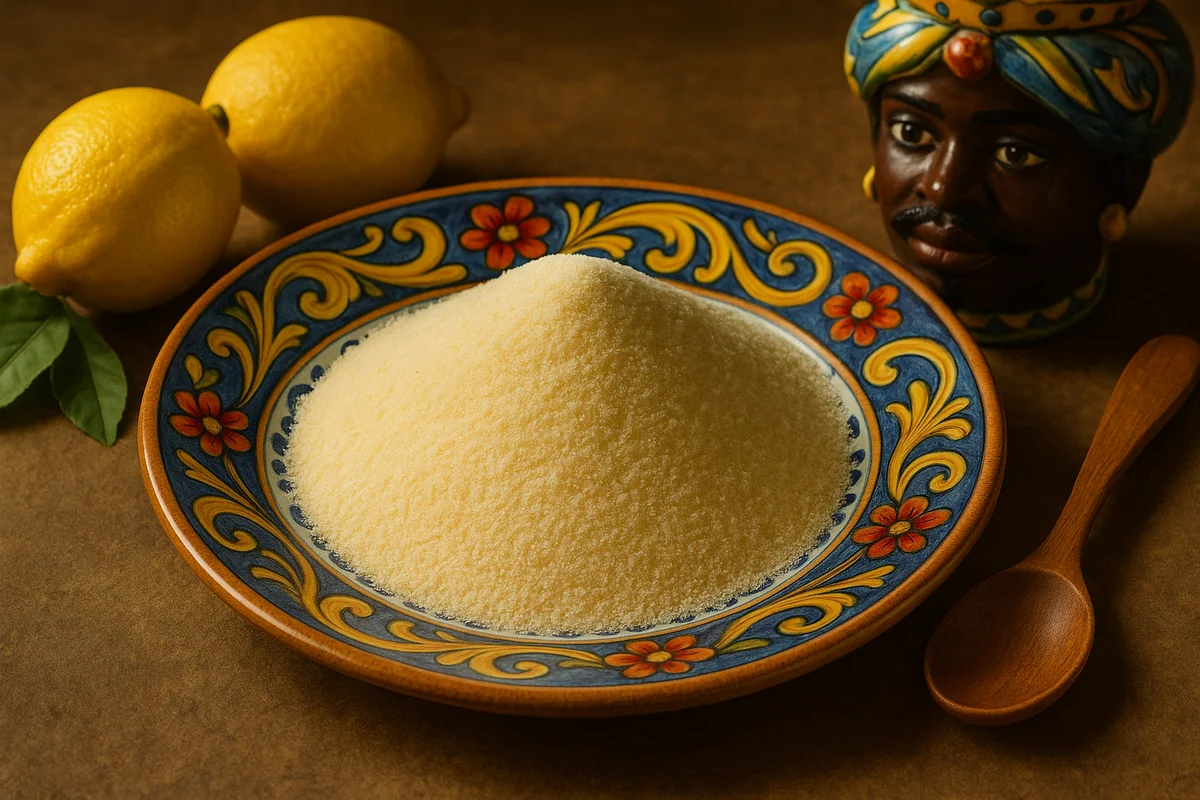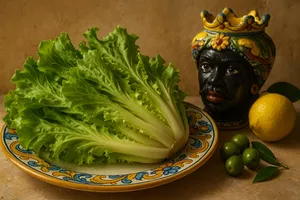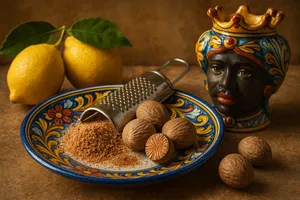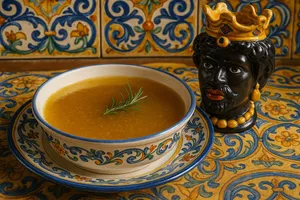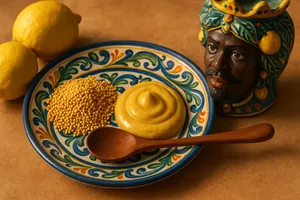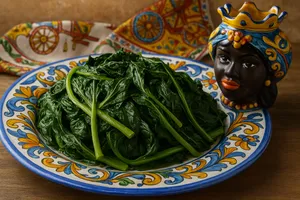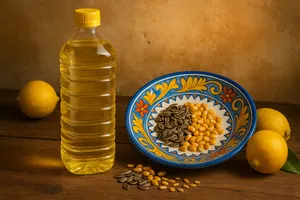Overview
Semolina, known in Sicilian as “simulinu” or “semolinu”, is a medium-grain coarse flour made from the milling of durum wheat (Triticum durum). It is characterised by a sandy texture, golden-yellow colour, and evenly sized granules visible to the naked eye. In Sicilian cuisine, semolina plays multiple roles: it is a key ingredient in traditional sweets (such as gattò, puddings, biscuits), in soups (semolina in broth), in savoury preparations (semolina gnocchi, croquettes, bakes), and as part of doughs for bread and homemade pasta. Sicilian durum semolina, produced from wheat grown in the island’s plains (Catania, Enna, Caltanissetta), is highly regarded and linked to Sicily’s millennia-old cereal tradition—the granary of the Roman Empire.
Semolina differs from standard flour primarily in its grain size: while flour is extremely fine, semolina has coarser grains that lend distinctive texture to dishes. It absorbs liquids slowly, swells during cooking, and creates dense, creamy textures. Nutritious and easily digestible, it was traditionally given to children, the elderly, and those recovering from illness. In Sicilian culture, semolina evokes childhood (semolina soup), festive desserts (gattò), and homely, comforting cooking. Humble yet versatile, it reflects rural wisdom and the resourceful use of local grains.
Characteristics
Semolina has a sandy, granular texture, golden-yellow colour (deeper than soft-wheat semolina, which is paler), and evenly sized medium granules (about 0.5–1 mm). It flows like fine sand. To the touch, it is dry and should not clump (a sign of good storage).
The flavour is delicate, slightly sweet, with the characteristic taste of wheat. Its aroma should be clean and cereal-like—never acidic, rancid, or mouldy. Fresh semolina has a pleasant, pure scent.
Semolina’s distinctive feature is its capacity to absorb large amounts of liquid, swelling during cooking to create dense, smooth, creamy preparations—ideal for puddings, soups, and gnocchi.
Durum semolina vs soft-wheat semolina
Durum wheat semolina (remilled semola): Golden-yellow, rich in strong gluten, high in protein (12–14%), with slightly larger grains. This is the traditional Sicilian type, used for pasta, sweets, and preparations requiring firmness. The most common and prized variety.
Soft-wheat semolina: Pale cream-coloured, with weaker gluten and lower protein content, and slightly finer grains. Less common in Sicily, mainly used for delicate sweets.
In Sicily, “semolina” without further specification almost always refers to durum wheat semolina.
Semolina vs semola
Semola (durum wheat): Coarser grind, 0.5–1 mm granules, intense yellow. Used for industrial dried pasta and homemade pasta. Rough texture.
Semolina (remilled semola): Semola ground again to produce finer grains (0.2–0.5 mm), smoother texture. Ideal for sweets and soups requiring a finer consistency.
Durum wheat flour: Very fine, powder-like texture. Used for bread, focaccia, and doughs requiring flour.
The difference lies in grain size: from coarsest (semola) to finest (flour), with semolina in between.
Production
Semolina is produced by milling durum wheat through processes that separate its components:
1. Cleaned durum wheat is milled in roller mills.
2. The gradual milling separates the endosperm (the starchy, protein-rich centre) from the bran and germ.
3. Coarsely milled endosperm becomes semola.
4. Semola is remilled more finely to produce semolina.
5. Semolina is sieved for uniform grain size.
In Sicily, the production of semolina from local durum wheat is an important tradition. Historic and modern mills transform locally grown wheat into semola, semolina, and flour of high quality.
Use in Sicilian cuisine
Gattò di semolina
A traditional Sicilian dessert: semolina cooked in milk with sugar, enriched with eggs, vanilla, and lemon zest, baked until golden. Firm enough to slice, delicately flavoured, and traditionally served on festive occasions.
Semolina pudding
A simpler version of gattò: semolina cooked in sweetened milk to a thick consistency, poured into moulds, cooled, and served with jam or chocolate.
Semolina in broth
A delicate soup: semolina cooked in vegetable or meat broth until creamy. A dish for children, the elderly, or convalescents, considered nourishing and gentle.
Semolina gnocchi (Roman style)
A preparation also adopted in Sicily: semolina cooked in milk, spread, cut into discs, and baked with butter and cheese.
Semolina croquettes
Thick semolina cooked with cheese, eggs, and aromatics, cooled, shaped into croquettes, breaded, and fried. Crisp outside, soft inside.
Cakes and biscuits
Semolina can partially replace flour in cakes and biscuits, creating a distinctive, slightly grainy, moist texture. Orange semolina cakes and semolina biscuits are traditional examples.
Bread and pasta doughs
Added to homemade bread, focaccia, and fresh pasta (especially filled pasta) to provide golden colour, firmness, and better cooking resistance.
Semolina couscous
In the Trapani tradition (with Arab influence), couscous is prepared by hand-working semolina with salted water until grains form, then steaming them. Laborious but central to Trapanese cuisine.
Basic semolina pudding
Simple recipe:
1. Bring 500 ml milk to the boil with 80g sugar and lemon zest or vanilla.
2. Sprinkle in 80–100g semolina while whisking to avoid lumps.
3. Simmer for 5–10 minutes until thick and creamy.
4. Remove from heat, discard zest.
5. Pour into moistened moulds and smooth the surface.
6. Cool, then refrigerate for at least 2 hours.
7. Unmould and serve with jam, honey, melted chocolate, or fruit.
The ratio of semolina to milk may vary depending on desired consistency.
Storage
Semolina should be stored in a cool, dry place, away from light, in an airtight container for 6–12 months. Moisture causes clumping and mould.
Once opened, transfer semolina to an airtight container to preserve freshness and prevent insect infestations.
Old or poorly stored semolina may turn rancid (oxidised fats in the germ), detectable by unpleasant odour or bitter taste. Discard if this occurs.
Buying tips
Choose high-quality durum wheat semolina, preferably Italian or Sicilian. Check expiry dates and packaging integrity.
The colour should be uniformly golden, the texture fine and free-flowing. Avoid semolina with clumps, dark spots, or off odours.
Organic semolina ensures absence of pesticides and sustainable cultivation. Semolina from ancient Sicilian wheat varieties (Timilia, Perciasacchi) offers distinctive flavour and aroma.
Nutritional properties
Durum semolina is an energy-rich food: 100g provide about 350–360 calories. It contains mainly complex carbohydrates (70–75g), 12–14g protein, 1–2g fat, and 3–4g fibre.
It is a good source of B vitamins (B1, B2, B3, folates) and minerals such as phosphorus, magnesium, iron, and potassium. Its glycaemic index is medium-high, so moderation is recommended for diabetics.
Easily digestible—especially when cooked in milk or broth—semolina is traditionally considered ideal for children, the elderly, and those recovering from illness.
Semolina in Sicilian tradition
Semolina has long held an important place in Sicilian food culture, tied to the island’s cereal heritage.
Gattò di semolina was a festive dessert, made for birthdays, name days, Easter, and Christmas. Its ingredients (milk, eggs, sugar) made it a special-occasion treat.
Semolina soup evokes childhood memories for many Sicilians, prepared by mothers and grandmothers as a nutritious, gentle food.
Sicilian mills—often water- or wind-powered—produced semola and semolina for local communities, serving as centres of agricultural life.
Curiosities
The word “semolina” derives from Latin simila, meaning fine flour, with the diminutive indicating its mid-range grain size.
Historically, semolina was considered medicinal food, used in hospitals and sanatoriums for its digestibility and nutritional value.
In some Sicilian areas, semolina was used in poultices for inflammation or abscesses—an example of traditional folk medicine.
Trapanese couscous, traditionally worked by hand in a large terracotta bowl (mafaradda), is an art passed down through generations.
The Sicilian saying “‘U simulinu fa beni a granni e nichi” (“Semolina is good for young and old alike”) reflects its reputation as a wholesome food.
During periods of scarcity, semolina cooked in milk or water was a complete, filling meal for families.
Semolina was even used in traditional cosmetics: face masks with semolina, milk, and honey were thought to nourish the skin.
Its granular texture makes it unsuitable for sifting like flour—its “imperfection” is, in fact, its distinctive strength.

